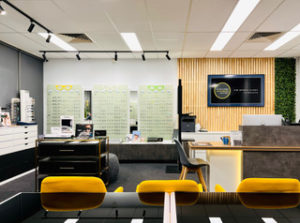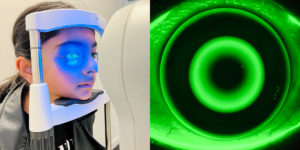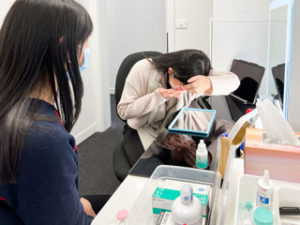October 17, 2022
By Philip Cheng, BOptom, FIAOMC
Through advancement in medical science, today’s kids have opportunities that I never had growing up with myopia. And I’m excited and optimistic about the future.
My journey into myopia management began in 2016 after attending an educational event hosted by the Brien Holden Vision Institute (BHVI) at the University of New South Wales in Sydney, Australia. This was in the very early days of myopia management when there was little widespread knowledge in the area. With strong emerging evidence that specific treatments can slow the progression of myopia, it seemed like an up-and-coming specialty. The science was compelling. Myopia management resonated with me because it was something tangible I could do to help current and future generations of children. As a high myope myself, I’ve had the experience of growing up with deteriorating eyesight from a young age, regularly needing stronger prescriptions in my glasses well into my adult life.
This myopia event at BHVI, held in memory of the late Professor Brien Holden — a great Australian pioneer in vision and eye care research — ignited a spark and a dream was born. I saw an opportunity to make a difference and knew myopia management was the niche in which I wanted to specialize. I was inspired to set up a clinic focusing on providing comprehensive myopia care for children. In 2017, I opened Eyecare Concepts as a brand-new, independent practice in Kew East, an inner-eastern suburb of Melbourne. In the beginning, we practiced primary eye care and started developing a patient base of adults and children, and from there, we were able to grow into The Myopia Clinic.
Now, five years later, 80% of what we do is myopia control and specialty contact lenses. We have become known as a destination clinic for myopia management, looking after patients across Melbourne and beyond. Last year we expanded our clinic at a new, purpose-designed office to cater to our rapidly growing patient base, partly attributed to the sharp rise in myopia cases from many months of lockdown and remote learning during the height of Covid. Our new clinic, now three times larger, consists of multiple consultation, diagnostic, and treatment rooms. The modern setting was designed to give a clinical yet relaxed, child-friendly ambiance. Our team has grown to eight staff members in various roles, including coordinating patient care, pre-testing, dispensing, and assisting in patient training in contact lenses and orthokeratology. All our staff are trained to be knowledgeable in myopia management to facilitate patient conversations.
Full Scope Myopia Care
We treat every patient with myopia who attends our clinic on a case-by-case basis. Myopia is an individual, multifactorial condition for every child — different levels of myopia, age of onset, rate of progression, past treatment history, genetics, and the environment, so it’s essential to consider all of those risk factors when commencing management.
We start with a comprehensive eye assessment, including refraction, ocular health, biometry, corneal topography, and binocular vision. We educate patients and their parents on what myopia is — more than just a vision condition. It is a progressive disease of eye elongation with potential lifelong eye health implications. We talk broadly about the four different treatment modalities — orthokeratology, soft contact lenses, spectacle lenses, and atropine — and then discuss the most appropriate intervention for the child. Treatment recommendations are based on considerations including the child’s age, refraction, axial length, corneal shape, risk profile, projection of myopia progression, and whether the child may be ready for contact lenses.
As a destination clinic, patients come to us expecting to be in the best hands. The most valuable source of new patients is word-of-mouth recommendations by existing patients who share their positive experiences with friends and family. Many patients are referred by other optometrists and doctors, and some find us through their research. Anxious parents come to our clinic with concerns for their children’s eyes and in the hope that we can help them. Some have never heard of myopia management before, and others already anticipate treatment and wait for us to validate which treatment option to proceed with. Parents want the best for their children and expect us to have the experience, knowledge, skills, and technologies to look after them for the long haul. Myopia management is a journey with a long-term commitment and regular reviews, and it’s paramount that parents feel confident in the doctor and the practice providing their care. It’s all about trust.
Our Number One Treatment is Orthokeratology
Orthokeratology has been our most popular myopia intervention and, in our experience, has proven to be one of the most effective treatments for slowing axial elongation. Many patients are drawn to the advantages of being glasses free during the daytime, which is excellent for sports and active lifestyles, and the convenience of wearing the lenses only during sleep. Parents of younger children tend to prefer this option over soft lenses, being able to supervise and apply the treatment at home. All of our OrthoK lenses are custom designed for each patient to help optimize treatment outcomes. Earlier this year, we celebrated the significant milestone of our clinic’s 1,000th OrthoK patient, which is a testament to our experience and the trust patients place in our clinic. Some parents whose children wear OrthoK become interested in the treatment for themselves and end up wearing OrthoK as well!
Spectacle Lenses for Myopia Management
Having novel spectacle lenses for myopia management has also opened up new opportunities to treat kids from an earlier age using an effective optical intervention. We know that early intervention is key and that younger children tend to progress faster. Gone are the days of prescribing single-vision lenses to start. As one of the first practices in Australia to have access to Hoya MiyoSmart spectacle lenses, we have been prescribing them for more than two years. Although I’ve found contact lenses to be generally more effective, sometimes the 4-, 5-, or 6-year-olds may be a little immature or too afraid to try contacts. Myopia management spectacle lenses are my go-to option for kids and parents who prefer to initiate treatment with glasses. These lenses provide vision correction while simultaneously slowing their progression, as long as they are fitted to a well-chosen frame and worn with good compliance. Children who start on these spectacles may eventually move onto OrthoK or soft contact lenses when they feel more ready or require a more effective intervention.
A Variety of Combination Treatments Are Also Effective
We’ve also used myopia management spectacles in conjunction with myopia management soft contact lenses. Depending on how often the patient wears contacts, the glasses can supplement their myopia treatment. If a child is wearing MiSight 1 day contact lenses six or seven days a week, their backup glasses could be single-vision lenses. But if the child only wears their contact lenses half the time, they will require alternative treatment the other half of the time, and myopia management spectacles enable us to do that.
Many of our patients receive combination treatments using an optical intervention with atropine. Biometry data guides our clinical judgment in each individual patient. Using axial length to monitor progression with greater sensitivity and precision objectively allows us to identify fast progressors and make swift decisions to add a second treatment when indicated. Children with earlier myopia onset, higher baseline myopia, longer axial length, and those of Asian ethnicity should be treated more aggressively, as their risk of developing high myopia is greater. We often see young patients with high myopia, regrettably without prior management, or who have not responded well to past attempts to slow progression. For these kids presenting with a -5.00D, -6.00D, or higher prescription and those with axial length approaching or exceeding 26mm, we must be more aggressive in our approach. Our goal is to tailor the treatment to the patient to slow their progression and axial elongation as much as possible.
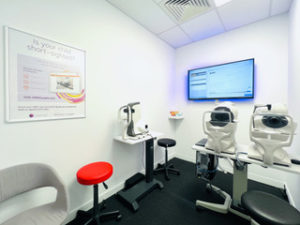 |
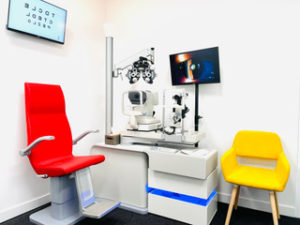 |
The Myopia Clinic features the most up-to-date instruments and technology.
Our experience in managing a wide range of myopia cases over the years, and the results we have seen using different treatment modalities, help shape our clinic’s data-driven treatment protocols and equip us to handle any myopia management case, simple or complex. Apart from our expertise, another factor that sets us apart is our advanced suite of clinical instruments. Patients want to be in a place where they can receive the best care. We’ve invested in the latest technologies because our patients and their parents invest a lot in us — their trust and their time, both emotionally and financially. We are privileged to be in the position of caring for over 2,000 active patients for myopia management, and it’s also a responsibility we take seriously.
Our clinic has the Medmont Meridia and E300 for topography and imaging, Oculus Keratograph 5 for dry eye analysis, and the Zeiss IOLMaster 500 and Oculus Myopia Master for biometry — we were one of the early adopters in measuring axial length for myopia management. We also have the Topcon Maestro OCT, Zeiss Humphrey Field Analyzer, and the Optos California ultra-widefield retinal scanner for screening and diagnosing pathology. As we know, myopia increases the lifetime risks of ocular disease and vision impairment, so adults with myopia will require ongoing comprehensive eye care and eye health assessment.
Developing a Solid Reputation
How do we spread the word about our myopia management specialty? In this day and age, a practice’s website is often the first touchpoint for potential patients. It’s an opportunity to present your practice professionally and share helpful information. Before anyone picks up the phone to make an appointment, they want to feel assured that our practice can help their child and provide the care they need. The website also serves as an educational portal for parents and a space for me to share my expertise in myopia management, which many patients appreciate from feedback that we received.
With a specialty practice, it’s crucial to have open channels for referrals. For practitioners specializing in this area, try to connect with each other as colleagues. When patients who reach out to us live far away or interstate and are unable to make the trip to see us, we can refer them to a suitable colleague who can serve them closer to home. Similarly, we get the word out to primary care practitioners, so they understand what we do. Whether it’s online or face-to-face, when I’m communicating with other optometrists, I want them to know that we are here to help. For challenging cases and patients who need biometry measurements or more advanced care, they know they can refer their patients to our office. I welcome optometrists to contact me if they wish to discuss any cases. I open my doors to students and practitioners to visit our clinic to see myopia management in action. When a patient is referred to us, it is essential to report back to the referring practitioner, who will be keen to learn how their patient has been managed. Regular communication and reporting patient outcomes help to build a solid reputation of our expertise in this field, which in turn helps to strengthen networks and generate more referrals.
Spreading Awareness of Myopia Management
Outside of the office, I’ve had the honor of regularly participating in speaking engagements at conferences and through webinars and podcasts, and it’s been a great way to spread the word about myopia management. I also enjoy online forum discussions with like-minded practitioners. It’s nice to be able to share my personal experiences with others. Sharing is integral to this journey; the more you listen and talk to other doctors, the more you learn. Everyone has different approaches to treating patients, and sharing ideas can benefit us all and help us grow professionally. Our patients reap the rewards of better care. With myopia management, there is always something new to learn, and it’s vital to keep up-to-date with the latest research and adapt our approaches accordingly as new findings come to light. As a leader in this area, I want to inspire others to incorporate myopia management into their practices and to provide myopia care at the highest level.
The prevalence of childhood myopia is rapidly growing. We’ve seen through Covid times that the environment plays a considerable role in myopia development, and kids in the future will likely spend more time on screens and digital devices as part of their learning and daily lives. It’s up to us as eye care professionals to become more proactive, educate patients and drive more parental awareness of what myopia is and how it can be managed. Myopia management, slowly but surely, is becoming a standard of care in optometry. Through advancement in medical science, today’s kids have opportunities that I never had growing up with myopia. And I’m excited and optimistic about the future. I think the next frontier in this fast-developing space will be to prevent the onset of myopia. If we are able to not only slow myopia progression but also prevent kids from becoming myopic in the first place, that would be amazing.
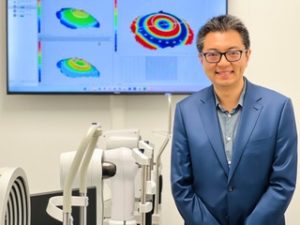 |
Philip Cheng graduated from University of Melbourne and is the founder of The Myopia Clinic Melbourne, a private practice focusing on children’s vision, myopia control, orthokeratology, and specialty contact lenses. Philip is internationally recognized as a leading practitioner in myopia management, and he has regularly presented and lectured on myopia in Australia and on the international stage. As a high myope himself, he is passionate about giving children the opportunity of better eyesight and eye health. He is a committee board member of the Orthokeratology Society of Oceania and a Fellow of the International Academy of Orthokeratology and Myopia Control.
|


